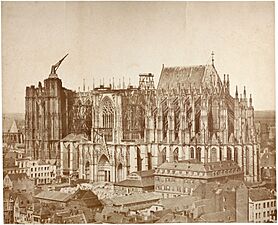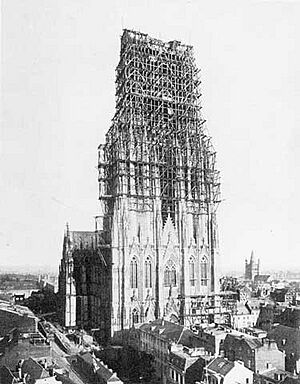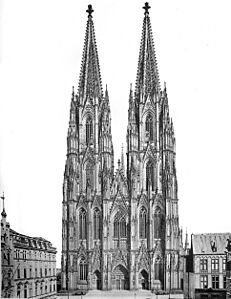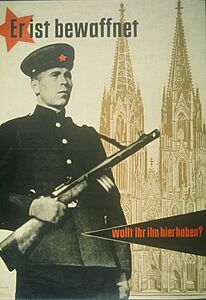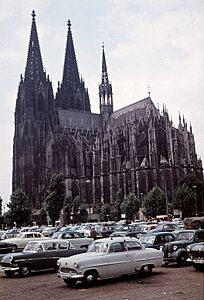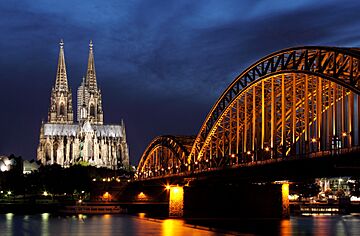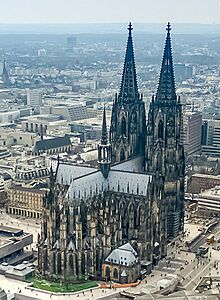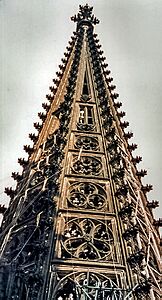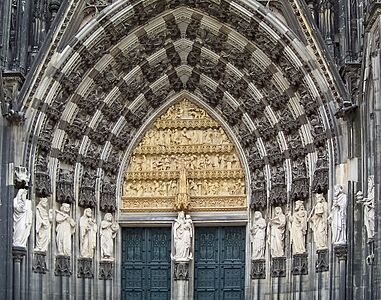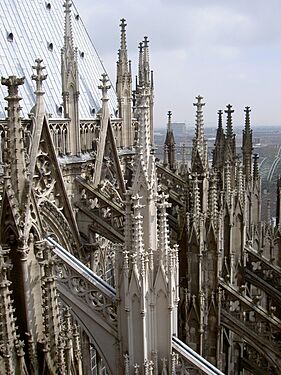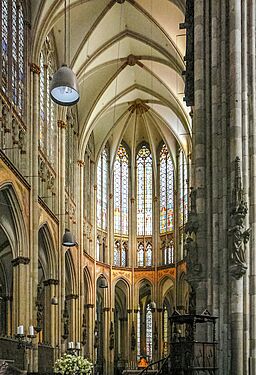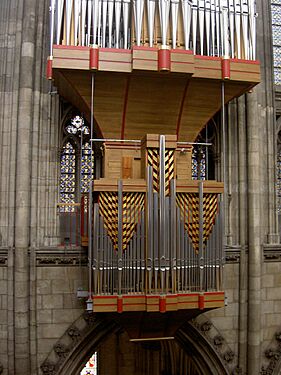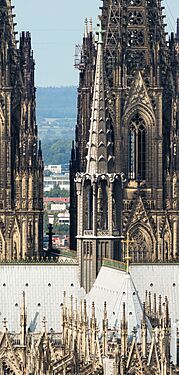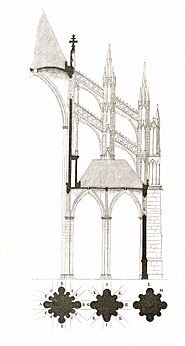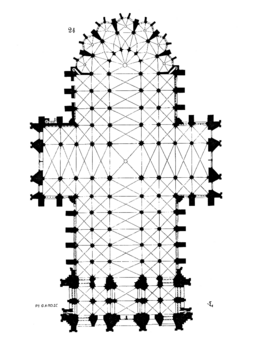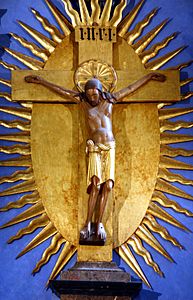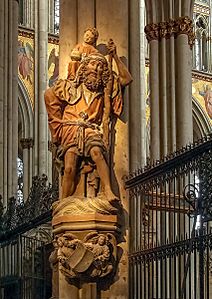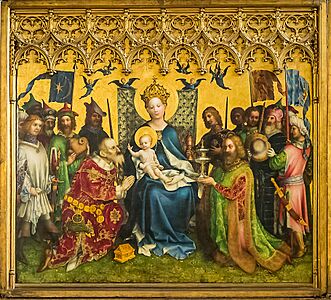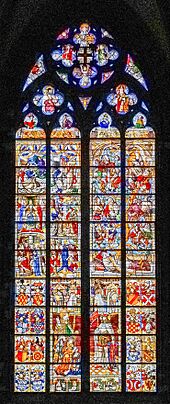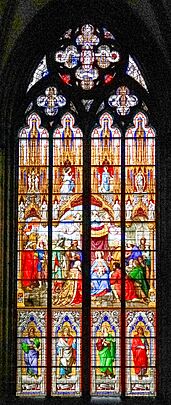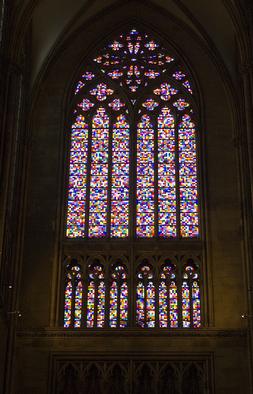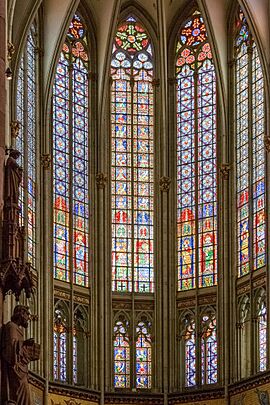Cologne Cathedral facts for kids
Quick facts for kids Cologne Cathedral |
|
|---|---|
| The Cathedral of St. Peter | |
|
|
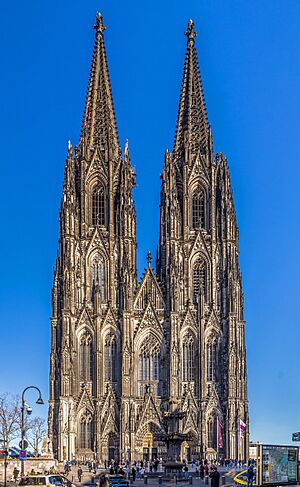
Cathedral façade
|
|
| 50°56′29″N 06°57′30″E / 50.94139°N 6.95833°E | |
| Location | Cologne |
| Country | Germany |
| Denomination | Catholic Church |
| Website | koelner-dom.de https://www.koelner-dom.de/en |
| History | |
| Status | Cathedral |
| Dedication | Saint Peter |
| Consecrated | 15 October 1880 |
| Architecture | |
| Functional status | Active |
| Style | Gothic |
| Years built |
|
| Specifications | |
| Length | 144.5 m (474 ft) |
| Width | 86.25 m (283.0 ft) |
| Number of spires | 2 |
| Spire height | 157 m (515 ft) |
| Bells | 11 |
| Administration | |
| Archdiocese | Cologne |
| Province | Cologne |
Cologne Cathedral (also known as Kölner Dom) is a famous church in Cologne, Germany. It belongs to the Catholic Church and is the main church for the Archbishop of Cologne. It's a huge example of Gothic architecture and was named a World Heritage Site in 1996.
This cathedral is Germany's most visited landmark, with about 6 million visitors every year. Standing at 157 m (515 ft) tall, it is the tallest church in the world with two spires. It's also the second tallest church in Europe, after Ulm Minster.
Building Cologne Cathedral started way back in 1248. But work stopped around 1560, leaving it unfinished for a long time. People tried to finish it again in the early 1800s, and by the 1840s, the project finally got enough money. The cathedral was completed exactly as planned in 1880. Its two massive towers give it the largest front of any church in the world.
The builders in medieval times wanted to create a grand church. It was meant to hold the special reliquary of the Three Kings. Even though it wasn't finished for centuries, Cologne Cathedral became known as "a masterpiece of exceptional value." It shows how strong Christian belief has been through history. In Cologne, only the telecommunications tower is taller than the cathedral.
Contents
Early Churches on the Site
Before the current Gothic cathedral, other churches stood on this important spot.
First Christian Buildings
The first bishop of Cologne, Maternus of Cologne, lived around 313 AD. At that time, Christians in Cologne met in a house, not a church. This house was likely on the same hill where the cathedral stands today.
Later, in the 6th century, a church was built here by the Merovingian kings. It was about 40 to 50 meters long. This church was a burial place for the royal family.
The Baptistery
Even in ancient times, there was a baptistery (a place for baptisms) east of the cathedral. Early Christians would step into knee-deep water there to be baptized. This baptismal pool from the 5th century is thought to be the oldest sign of Christian worship in Cologne. Today, you can still see this pool in the cathedral's base.
Hildebold Cathedral: A Grand Predecessor
During the time of Charlemagne, a large church called Hildebold Cathedral was built on Cologne Cathedral Hill. It was dedicated in 870 AD. This church was named after Bishop Hildebold of Cologne, who was a close friend of Charlemagne.
Hildebold Cathedral was about 95 meters long, making it one of the biggest churches of its time. It was designed like a basilica with two main areas for worship. The church was seen as the "St. Peter's Basilica of the North," showing Cologne's importance. Important items like the staff and chains of Saint Peter were kept there.
On July 23, 1164, the bones of the Three Wise Men were brought to Cologne from Milan. These relics were very important and made Cologne a famous place for pilgrims. To hold these precious relics, the beautiful Shrine of the Three Kings was created between 1190 and 1225. This shrine is one of the most amazing gold artworks from the Middle Ages.
When the Gothic cathedral started being built in 1248, the old Hildebold Cathedral was slowly taken down. However, a fire accidentally destroyed most of it. Luckily, the Shrine of the Three Kings was saved.
Building the Gothic Cathedral
Starting the Medieval Construction
The first stone of the new Gothic cathedral was laid on August 15, 1248, by Archbishop Konrad von Hochstaden. The eastern part of the church was finished first, around 1322. It was then sealed off with a temporary wall so it could be used while the rest of the building continued.
Work on the cathedral stopped in 1473. The south tower was only built up to the bell level and had a huge crane on top. This crane stayed there for 400 years and became a famous landmark in Cologne. Some work continued on the main part of the church, but by the 16th century, that also stopped.
Finishing in the 19th Century
In the 1800s, people became very interested in the Middle Ages. When the original plans for the cathedral's front were found, there was a big push to finish it. The Prussian government, working with the church, decided to complete the building.
Most of the money came from a group called the Central-Dombauverein, started in 1842. They raised two-thirds of the huge cost, and the Prussian state paid the rest. This project also helped improve relations between the state and its many Catholic citizens.
Construction started again in 1842, following the old medieval plans but using newer building methods. The main part of the church was completed, and all three towers were added. Bells were put in during the 1870s, including the massive St. Petersglocke.
The completion of Germany's largest cathedral was a huge national celebration on October 15, 1880. This was 632 years after construction began! For four years, at 157.38 m (516.3 ft), it was the tallest building in the world, until the Washington Monument was finished.
World War II and Beyond
During World War II, the cathedral's tall spires were an easy target for Allied planes bombing Cologne. The cathedral was hit by bombs 14 times. Even though it was badly damaged, it remained standing in a city that was almost completely destroyed.
On March 6, 1945, there was a fierce battle near the cathedral between American tanks and a German tank. Film footage of this battle still exists.
Repairs to the war damage were finished enough for the cathedral to reopen in 1956. Some parts, like the central tower, were redesigned. A repair on the northwest tower, made with poor-quality bricks in 1944, was visible until 2005. It was then restored to its original look.
Archaeological digs started in 1946 to see if the bombings had damaged the cathedral's foundations. These digs uncovered amazing details about earlier buildings on the site.
The cathedral always has some scaffolding on it because wind, rain, and pollution slowly wear away the stones. A special workshop, the Dombauhütte, employs skilled stonemasons to keep the cathedral in good repair. Half the cost of these repairs is still paid by the Dombauverein.
The Cathedral in the 21st Century
On August 18, 2005, Pope Benedict XVI visited the cathedral during World Youth Day 2005. About a million pilgrims came to the cathedral during this time.
In 2007, the cathedral got a new stained glass window in the south transept. The 113 m2 (1,220 sq ft) window was designed by German artist Gerhard Richter. It has 11,500 pieces of colored glass, arranged randomly by computer, creating a colorful "carpet" effect.
On January 5, 2015, the cathedral's floodlights were turned off to protest a demonstration. This made the cathedral appear dark.
Art and History: Learning from the Past
In the 2000s, the cathedral leaders started looking closely at some of the older artworks in the cathedral. Some of these artworks had images that were unfair or harmful towards Jewish people. Artists and scholars encouraged the cathedral to address this history.
In 2017, a special group was formed to study "The Cathedral and 'the Jews'." This group decided not to remove or change the old artworks. Instead, they want visitors to see them in their original place and learn about their history. The cathedral now offers special tours to help people understand these artworks.
The working group also decided to add new art to the cathedral. This new art would openly acknowledge the full history of Jewish-Christian relations. It would also focus on their present and future. In August 2023, a competition was launched for this new artwork.
In April 2025, Andrea Büttner won the competition. Her proposed mural for the Chapel of St. Mary will show a life-size painting of the stone base of a Torah ark from an old synagogue in Cologne. This base was hidden for a long time. Büttner wants her art to "take something that has been hidden... and have it openly displayed in a central location." This project helps to highlight and acknowledge Jewish history in Cologne.
A World Heritage Site
In 1996, the cathedral was added to the UNESCO World Heritage List. This list includes important cultural sites around the world. In 2004, it was briefly put on the "World Heritage in Danger" list. This was because there were plans to build tall buildings nearby that would block the view of the cathedral. But in 2006, the cathedral was removed from this list after officials agreed to limit the height of new buildings.
As a World Heritage Site and home to the Shrine of the Three Kings, Cologne Cathedral is a major attraction. It's one of the oldest and most important pilgrimage sites in Northern Europe. Visitors can climb 533 stone steps to a viewing platform about 100 m (330 ft) high. From there, you get a beautiful view over the Rhine River.
Keeping the Cathedral Strong
Cologne Cathedral is a very strong medieval building. However, its stone structure needs constant care and repair. The cathedral's master builder, Barbara Schock-Werner, once said, "Cologne Cathedral without scaffolding is not a pipe dream, but a nightmare." This means that without constant repairs, the cathedral would not last.
After the cathedral was officially finished in 1880, work continued for about 20 more years. But even after that, repairs had to start again when parts of an angel statue fell off in 1906.
The cathedral is built from different types of stone. These stones wear away at different rates due to weather, air pollution, and even bird droppings. In the 1960s, acid rain badly damaged the stones, turning them black. Since the 1990s, air pollution has been reduced, which helps.
Some types of sandstone used in the 1800s wear away quickly. These stones are constantly replaced. Today, builders try to use new stones that look as much like the original sandstone as possible. Also, the iron parts that hold the decorations are rusting and need to be replaced with steel. Because of all this, it's likely that no one alive today will ever see the cathedral completely without scaffolding.
The cathedral also needs repairs because of occasional earthquake damage. For example, during the 1992 Roermond earthquake, a 400 kg stone decoration broke off and crashed through the roof.
In 2021, a drone took 200,000 high-resolution photos of the cathedral. These photos were used to create a detailed 3D model. This model helps experts see exactly what repairs are needed, even in hard-to-reach areas.
Cathedral Design
The design of Cologne Cathedral is very similar to Amiens Cathedral in France. It has the shape of a Latin Cross, which is common for Gothic cathedrals. It has two side aisles that help support its very tall Gothic ceilings. These ceilings are almost as tall as those in Beauvais Cathedral. Outside, large flying buttresses help support the walls. The eastern end has a walkway with seven small chapels around it.
Inside, the medieval choir (the area near the altar) has many unique details. It has tall arches, a narrow gallery with windows, and beautiful stone patterns. The tall windows let in a lot of light. The whole space feels connected by tall columns that reach from the floor to the ceiling.
The choir still has many of its original features, including carved wooden seats. A large stone statue of St Christopher looks down from above. The main part of the church has many stained glass windows from the 1800s. Five of these, called the Bayernfenster, were a gift from Ludwig I of Bavaria.
From the outside, especially from far away, the cathedral is known for its huge spires. These spires are very German in style, with open, lacy stonework, similar to those in Ulm or Strasbourg.
Cathedral Size
| Outside length | 144.58 m (474.3 ft) |
| Outside width | 86.25 m (283.0 ft) |
| Width of west front | 61.54 m (201.9 ft) |
| Width of transept front | 39.95 m (131.1 ft) |
| Width of nave (inside, with aisles) | 45.19 m (148.3 ft) |
| Height of southern tower | 157.31 m (516.1 ft) |
| Height of northern tower | 157.38 m (516.3 ft) |
| Inside height of nave | 43.35 m (142.2 ft) |
| Building area | 7,914 m2 (85,185.59 sq ft) |
| Window area | 10,000 m2 (107,639.10 sq ft) |
| Roof area | 12,000 m2 (129,166.93 sq ft) |
Special Treasures
One of the most important items in the cathedral is the high altar, put in place in 1322. It is made of black marble with a huge top slab 15 ft (4.6 m) long. The front has white marble carvings showing figures, with the Coronation of the Virgin in the middle.
The most famous artwork is the Shrine of the Three Kings. It was started in 1190 and is believed to hold the bones of the Three Wise Men. The shrine looks like a small church and is made of bronze and silver, covered in gold, jewels, and detailed carvings. When it was opened in 1864, bones and clothes were found inside.
Near the sacristy (a room for church items) is the Gero Crucifix. This is a large crucifix carved from oak, with traces of paint and gold. It was made around 960 AD and is the oldest large crucifix north of the Alps.
In the Sacrament Chapel, you can find the Mailänder Madonna ("Milan Madonna"). This is a beautiful Gothic carving of the Virgin Mary and baby Jesus, made around 1290. The altar of the patron saints of Cologne, with a painting by Stefan Lochner, is in the St. Mary's Chapel.
The radiating chapels were used as burial places after 1265. The remains of Saint Irmgardis are in the St. Agnes' Chapel. Her stone coffin was made around 1280. Other valuable items are kept in the Cathedral Treasury.
Two stone tablets are built into an inside wall. They show the rules set by Archbishop Englebert II (1262–67) that allowed Jewish people to live in Cologne.
-
St. Christopher statue, around 1470
-
The Dombild Altarpiece of the Three Kings by Stefan Lochner
-
Modern stained glass window by Gerhard Richter (2007)
Church Music and Bells
Cologne Cathedral has two large pipe organs. One was built in 1948, and the other in 1998.
The Bells of Cologne Cathedral
The cathedral has eleven church bells. Four of them are very old, from the medieval period. The first was the 3.8-tonne Dreikönigsglocke ("Bell of the Three Kings"), cast in 1418. Two other large bells, the Pretiosa (10.5 tonnes) and the Speciosa (5.6 tonnes), were installed in 1448 and are still there today.
In the 1800s, as the cathedral was being finished, people wanted more bells. The German Emperor Wilhelm I even donated French cannons captured in war for this purpose. A huge bell called the Kaiserglocke was cast from these cannons in 1873. It was the largest free-swinging bell in history, but it was melted down in 1918 to help with the German war effort.
The 24-tonne St. Petersglocke ("Bell of St. Peter"), also known as "Decke Pitter" in the local language, was cast in 1922. It was the largest free-swinging bell in the world for many years. This bell is only rung on eight major holidays, like Easter and Christmas.
On March 3, 2022, cathedrals across Europe, including Cologne Cathedral, rang their bells together. This was a sign of support for Ukraine and a prayer for peace.
| Name | No | Mass | Note | Founder | Year |
|---|---|---|---|---|---|
| St. Peter's Bell (Dicker Pitter) | 1 | 24,000 kg | C0 | Heinrich Ulrich, Apolda | 1923 |
| Pretiosa | 2 | 10,500 kg | G1 | Heinrich Brodermann & Christian Cloit, Cologne | 1448 |
| Speciosa | 3 | 5,600 kg | A1 | Johannes Hoerken de Vechel, Cologne | 1449 |
| Dreikönigsglocke (Three Kings Bell) | 4 | 3,800 kg | H0 | Hermann Große, Dresden | 1880 |
| St. Ursula's Bell (Ursulaglocke) | 5 | 2,500 kg | C1 | Joseph Beduwe, Aachen | 1862 |
| St. Joseph's Bell (Josephglocke) | 6 | 2,200 kg | D2 | Hans Augustus Mark, Eifel Foundry, Brockscheid | 1998 |
| Chapter Bell (Kapitelsglocke) | 7 | 1,400 kg | E2 | Karl I Otto, Bremen | 1911 |
| Hail Bell (Aveglocke) | 8 | 830 kg | G2 | Karl I Otto, Bremen | 1911 |
| Name | No | Weight | Note | Founder | Year |
|---|---|---|---|---|---|
| Angelusglocke | 9 | 762 | G♯2 | Unknown | 14th century |
| Mettglocke | 10 | 280 | B2 | Antonius Cobelenz, Cologne | 1719 |
| Wandlungsglocke | 11 | 428 | E3 | Unknown | 14th century |
See also
 In Spanish: Catedral de Colonia para niños
In Spanish: Catedral de Colonia para niños
- Gothic cathedrals and churches
- List of Gothic Cathedrals in Europe
- Architecture of cathedrals and great churches
- Gero Cross
- Gothic architecture
- Gothic Revival architecture
- List of buildings and structures
- List of highest church naves
- List of cathedrals in Germany
- List of tallest structures built before the 20th century





